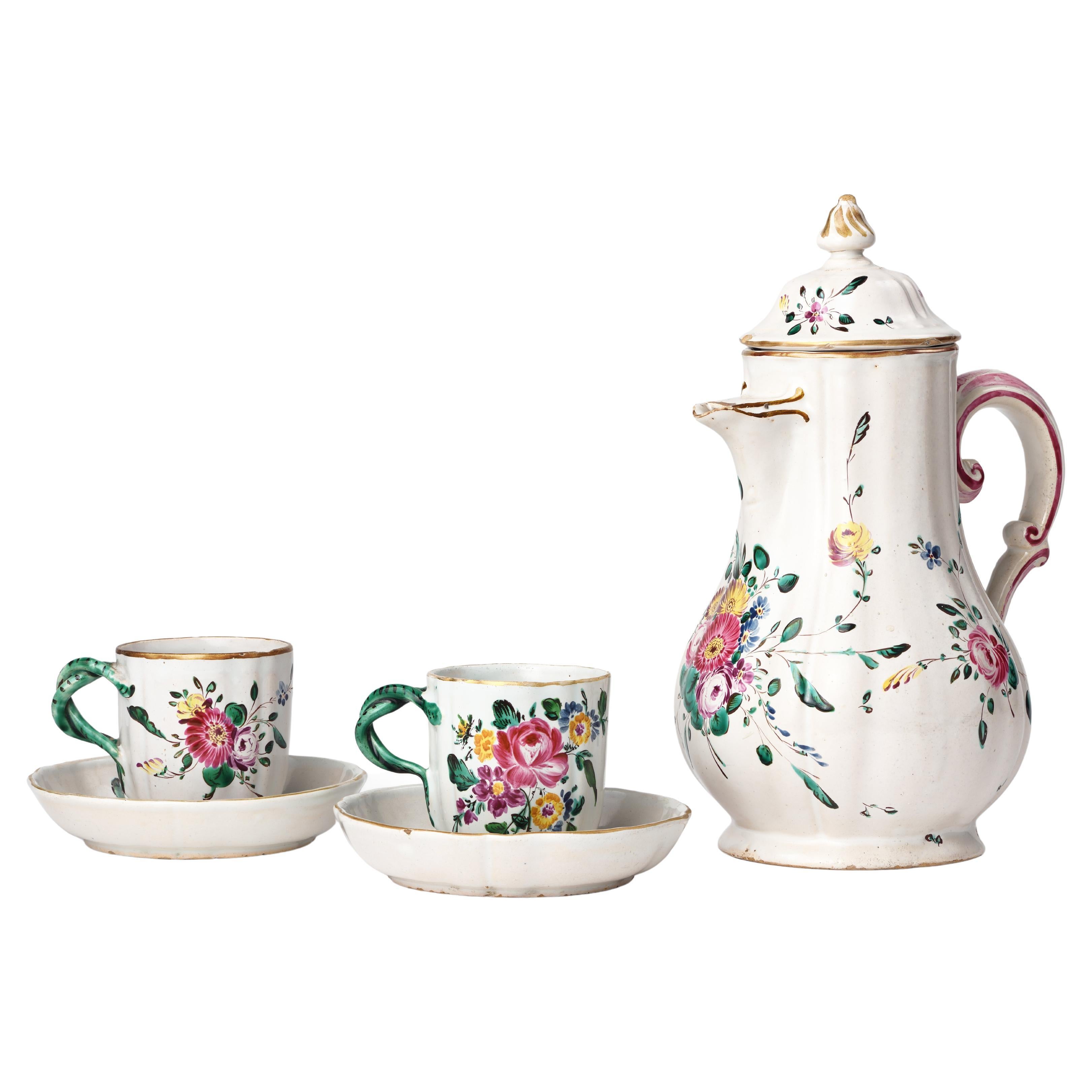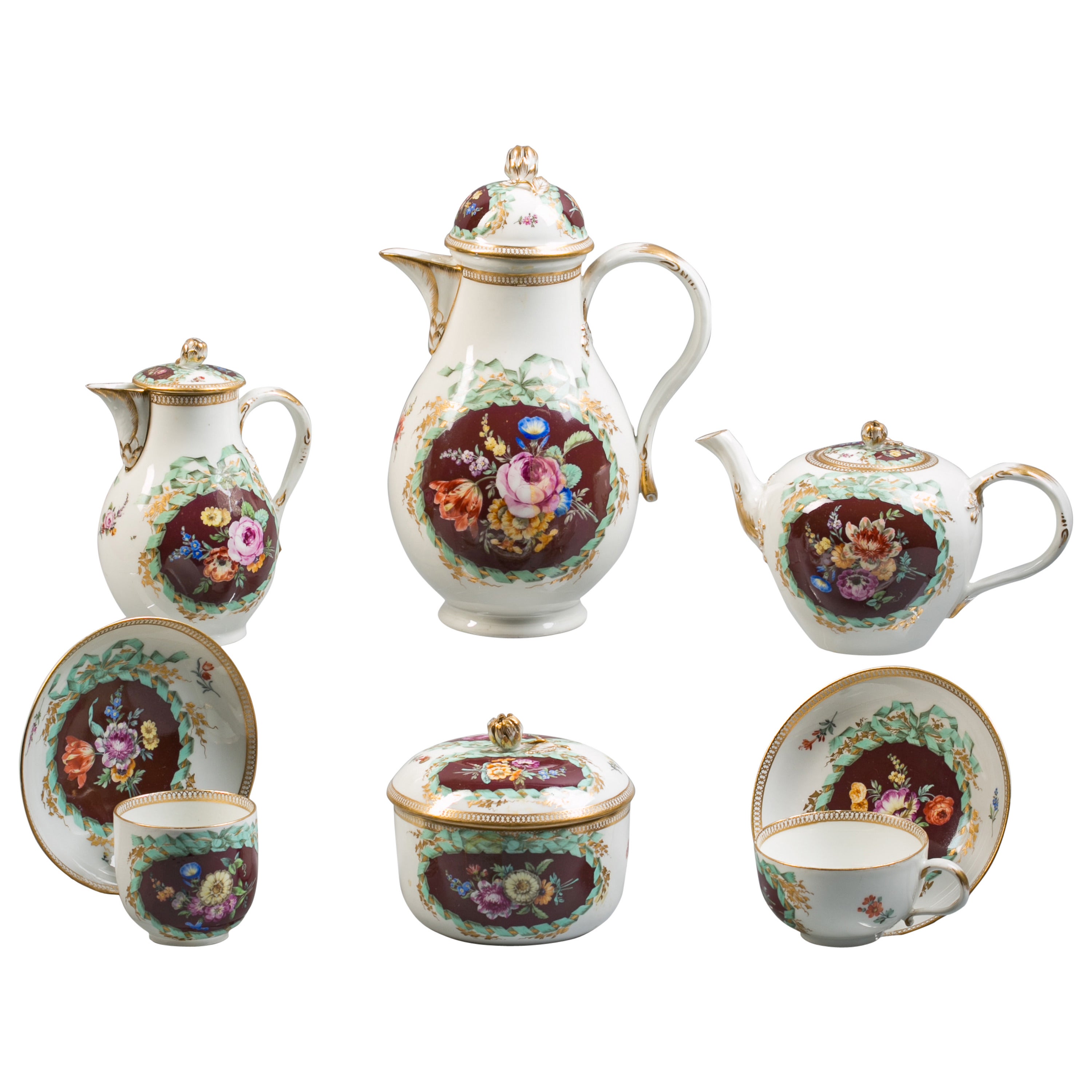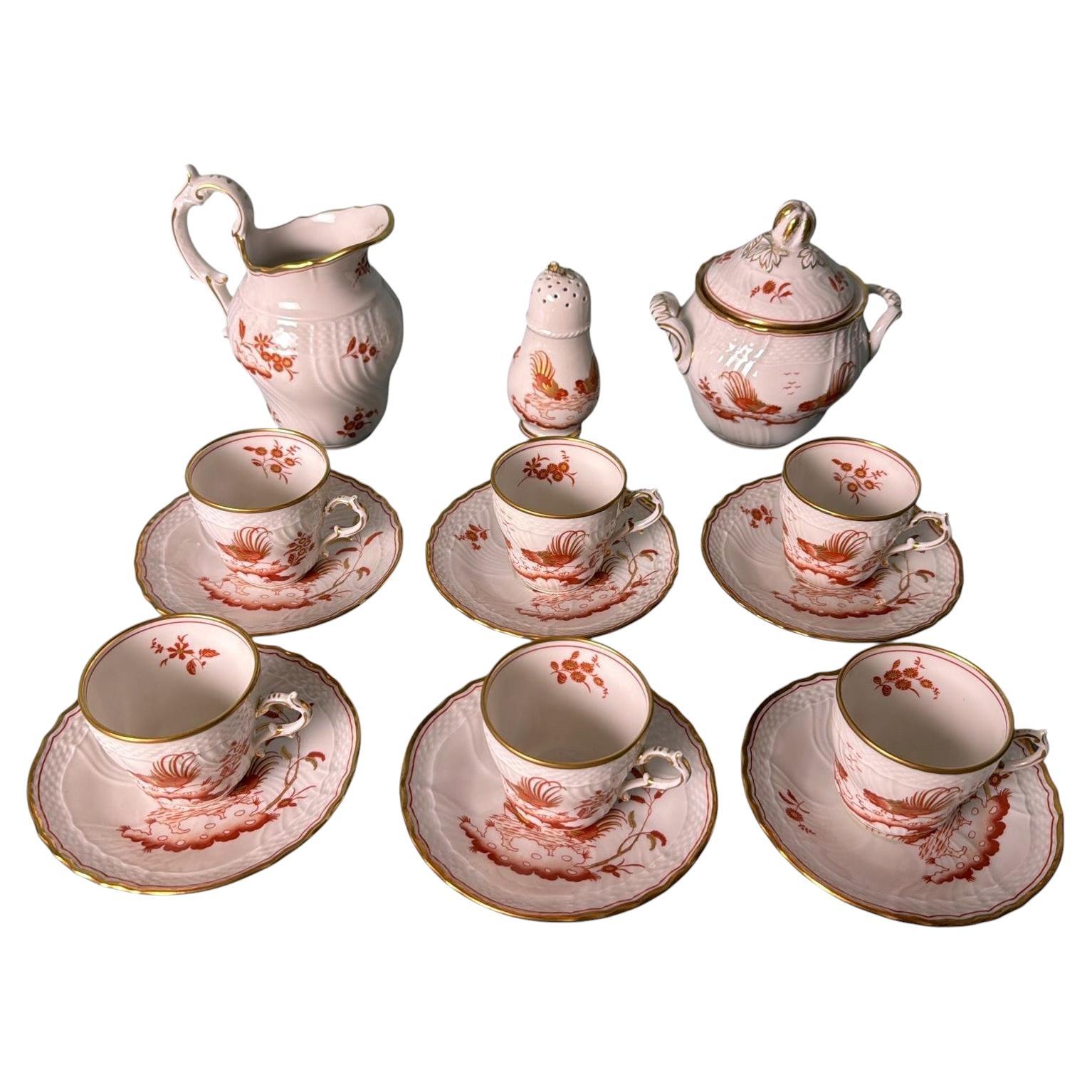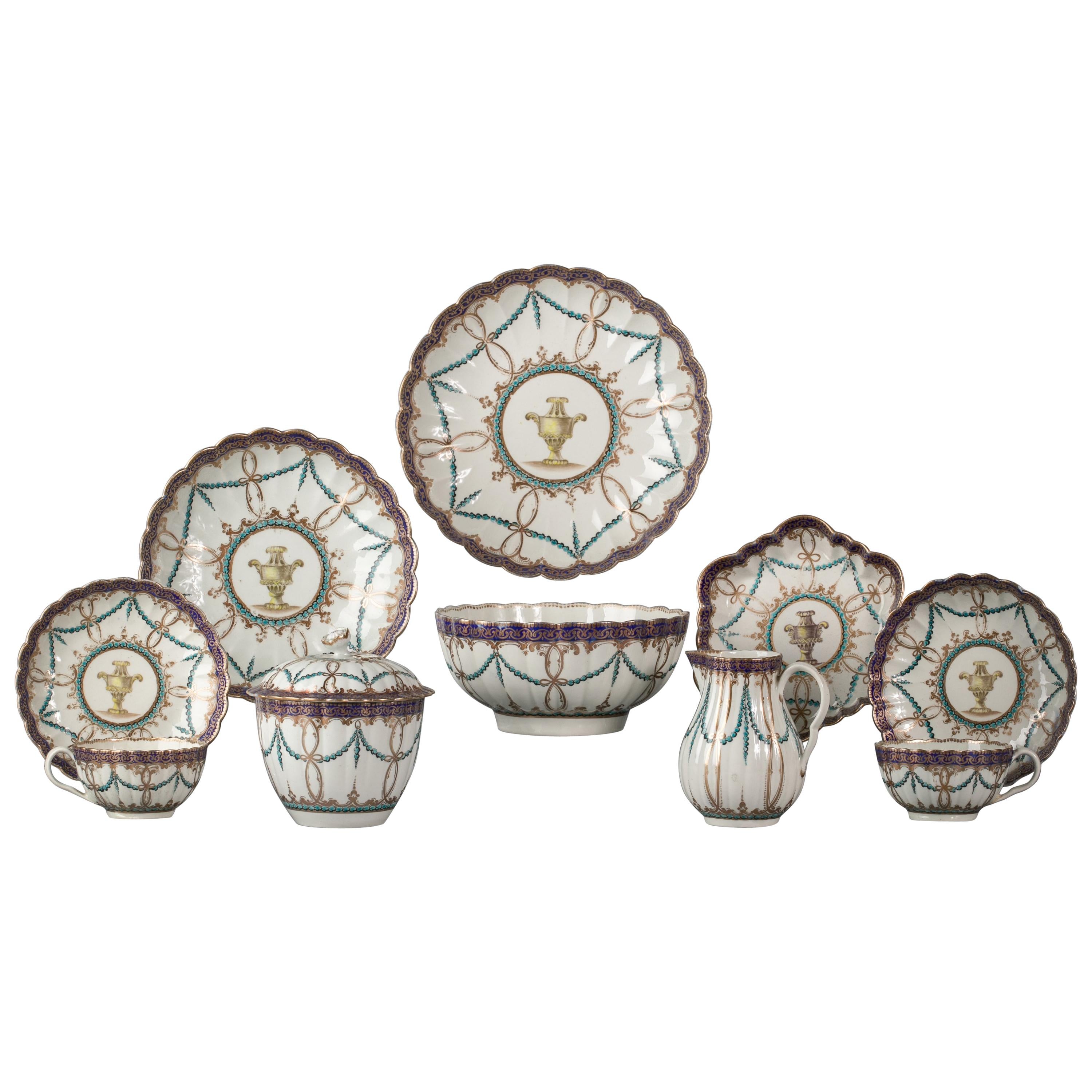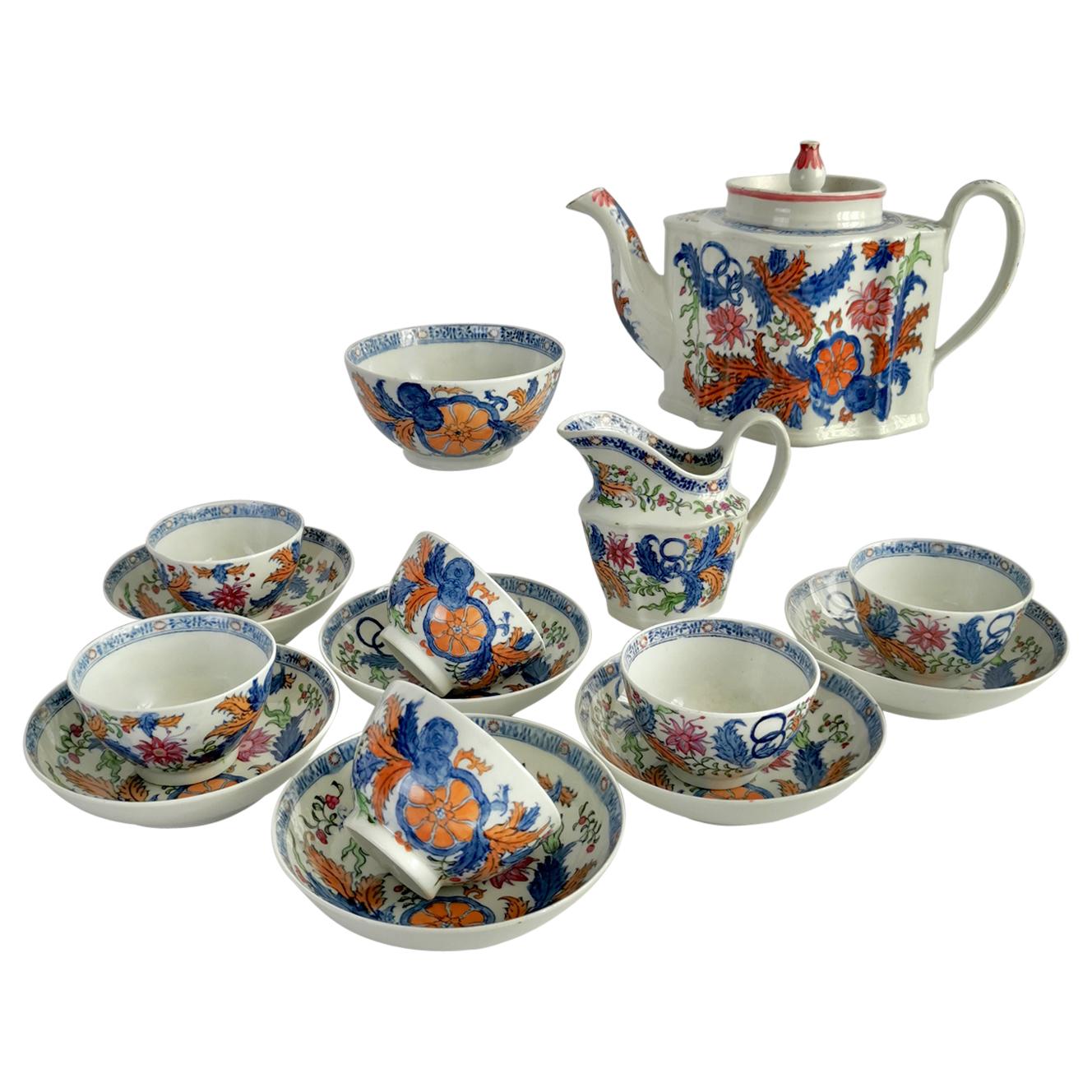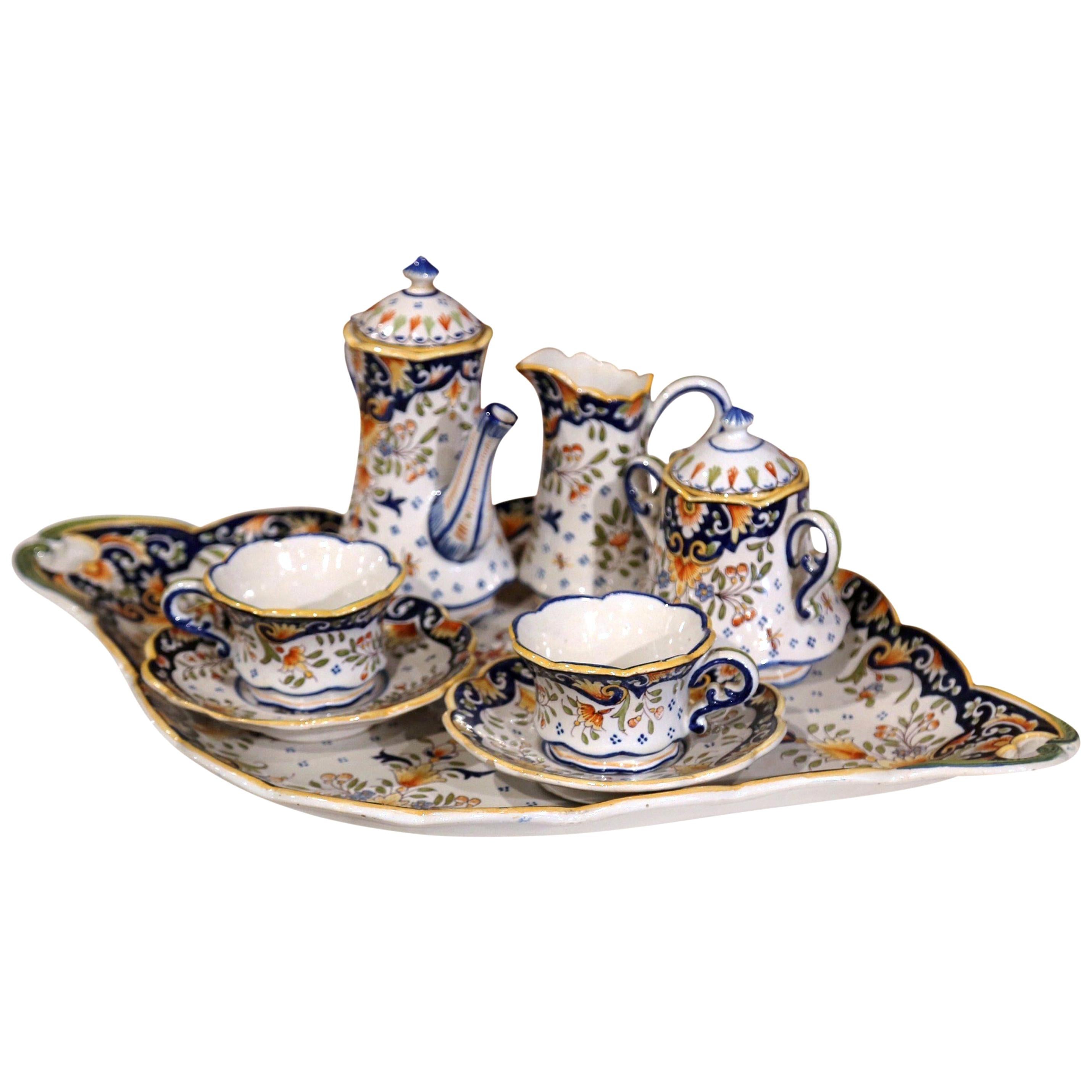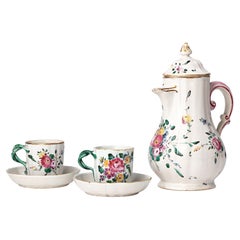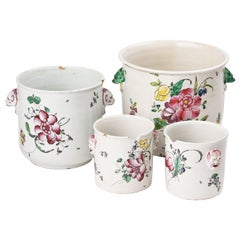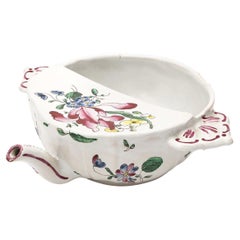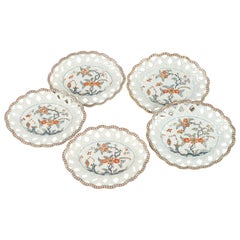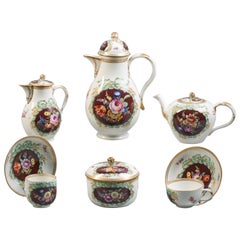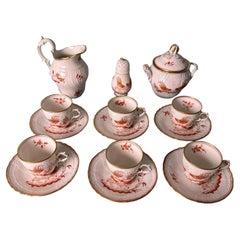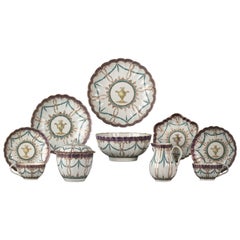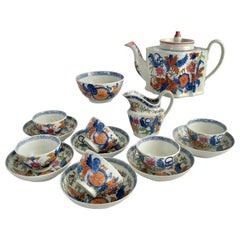Items Similar to Ancient Maiolica Coffee Set “Barbotine” Decoration Milan, 1770- 1780
Video Loading
Want more images or videos?
Request additional images or videos from the seller
1 of 22
Ancient Maiolica Coffee Set “Barbotine” Decoration Milan, 1770- 1780
$5,391.65per set
£4,012.99per set
€4,500per set
CA$7,385.21per set
A$8,213.96per set
CHF 4,289.08per set
MX$99,955.19per set
NOK 54,778.05per set
SEK 51,372.14per set
DKK 34,256.93per set
Shipping
Retrieving quote...The 1stDibs Promise:
Authenticity Guarantee,
Money-Back Guarantee,
24-Hour Cancellation
About the Item
Coffee assortment with “barbotine” decoration
Manufacture of Pasquale Rubati or Felice Clerici
Milan, 1770- 1780
Maiolica polychrome decorated “a piccolo fuoco” (third fire).
They measure:
Coffee pot: 7.48 x 5.90 x 6.10 in (19 x 15 x 15.5 cm); weight 1.2 lb (574 g).
Sugar bowl: 2.40 x 4.92 x 3.74 in (9.5 x 12.5 x 9.5 cm); weight 0.5 (223 g).
Cup with saucer: the cup 1.77 x 3.14 in (cm 4.5 x 8) and the saucer diameter 4.92 in (12.5 cm); weight 0.4 lb (186 g).
The coffee pot bears under the base the label of the famous exhibition of the Poldi Pezzoli Museum of 1964.
State of conservation: the coffee pot has the addition of a grip lid and a covered chip on the edge; the body is affected by a crack that runs from the mouth along the body and around the belly of the container. The sugar bowl has two restored chips on the edge of the lid and two minor chips visible at the edge of the bowl. The cup and saucer are intact.
The maiolica and porcelain factories of the eighteenth century mainly belonged to great royal or noble families who made the manufacture of ceramic works a sign of prestige. In Milan, under Maria Teresa of Austria, the time period witnessed a real opening to new industrialists who, by virtue of the privatizations granted by the government, assumed a real business risk, giving life, albeit not without conflict, to flourishing factories and to production which was among the most elegant and most requested at the moment and which still today remains object of collection. In Milan in the 18th century, two maiolica factories were active. The first was that of Felice Clerici, from 1745, and the second was opened by Pasquale Rubati in 1756, in competition with Felice, for whom he had been a worker. Upon Rubati's death, in 1796, the enterprise was continued for a few years under his son Carlo.
The series of objects is decorated with flowers in relief, a subject referred to in the inventories as “alla barbottina”, to indicate the technique used to make it. The decorative motif features some many petalled flowers in relief, partly connected by little manganese branches with thin cobalt blue and copper green leaves and small insects scattered over the rest of the surface.
The ornamentation originates from Chinese blanc de Chine decorations in relief or in any case from motifs from Canton. This style became one of the most sought-after decorations produced in Milan during the late eighteenth-century.
The enamel is thin and blue whereas the polychromy is full and shows a skilful use of the various shades of green and the presence of "ferraccia" red. The flower corollas are obtained by applying thin spheres of very diluted clay, the “barbottina”, then shaped and left to dry.
The coffee pot, with an enlarged, rotund, ribbed pyriform body, has a griffin beak pourer and a shaped handle, decorated in iron red; the lid is slightly raised and surmounted by a button knob (added during restoration.
The oval sugar bowl, with a poded and swollen profile, has a coherent lid surmounted by a pear-shaped knob.
The assortment is completed with an oriental-style bowl, without handle, but accompanied by a round saucer with a high brim and a ring foot.
These are some of the most typical forms of production of the Clerici factory in Milan, even if, at least in the initial period, they were all also adopted by the competing manufacture of Pasquale Rubati. The latter boasted of having used this very decoration: "not found in any other factory", as confirmed by some well-known pieces that bear his signature (G. Gregorietti, Maioliche di Lodi, Milan and Pavia, exhibition catalog, Poldi Pezzoli Museum, Milan 1964, n. 386), while those known under the Clerici brand are few and probably replacement pieces (G. Gregorietti, Maioliche di Lodi, Milano e Pavia, exhibition catalogue, Museo Poldi Pezzoli, Milano 1964 n. 388).
Various examples of comparison are known in public and private collections. Of particular interest is the comparison with the large group of "alla barbottina" works preserved in the Museum of Applied Art of the Castello Sforzesco in Milan (R. Ausenda, curated by, Musei e Gallerie di Milano. Museo d’Arti Applicate. Le ceramiche, Tomo secondo, Milano 2001 pp. 372-384, nn. 360-362.)
Bibliography:
G. Gregorietti, Maioliche di Lodi, Milano e Pavia, catalogo della mostra Museo Poldi Pezzoli, Milano 1964, nn. 390 the coffee pot; e 389-392 comparisons;
R. Ausenda, a cura di, Musei e Gallerie di Milano. Museo d’Arti Applicate. Le ceramiche, Tomo secondo, Milano 2001, pp. 372-384, nn. 360-362.
- Creator:Pasquale Rubati (Manufacturer)
- Dimensions:Height: 7.49 in (19 cm)Width: 5.91 in (15 cm)Depth: 6.11 in (15.5 cm)
- Sold As:Set of 3
- Style:Rococo (Of the Period)
- Materials and Techniques:Maiolica,Glazed
- Place of Origin:
- Period:1770-1779
- Date of Manufacture:1770-1780
- Condition:Repaired: The coffee pot has the addition of a grip lid. Minor losses. Minor fading. The coffee pot has the addition of a grip lid and a covered chip on the edge; the body is affected by a crack that runs from the mouth along the body and around the belly of the container. The sugar bowl has two restored chips on the edge of the lid.
- Seller Location:Milano, IT
- Reference Number:1stDibs: LU4352227685212
About the Seller
4.3
Vetted Professional Seller
Every seller passes strict standards for authenticity and reliability
Established in 1860
1stDibs seller since 2018
21 sales on 1stDibs
Associations
International Confederation of Art and Antique Dealers' Associations
- ShippingRetrieving quote...Shipping from: Milano, Italy
- Return Policy
Authenticity Guarantee
In the unlikely event there’s an issue with an item’s authenticity, contact us within 1 year for a full refund. DetailsMoney-Back Guarantee
If your item is not as described, is damaged in transit, or does not arrive, contact us within 7 days for a full refund. Details24-Hour Cancellation
You have a 24-hour grace period in which to reconsider your purchase, with no questions asked.Vetted Professional Sellers
Our world-class sellers must adhere to strict standards for service and quality, maintaining the integrity of our listings.Price-Match Guarantee
If you find that a seller listed the same item for a lower price elsewhere, we’ll match it.Trusted Global Delivery
Our best-in-class carrier network provides specialized shipping options worldwide, including custom delivery.More From This Seller
View AllAncient Italian Assortment Coffe Pot and Cups, Lodi, Circa 1765-1770
By Antonio Ferretti
Located in Milano, IT
A coffee pot and two cups with saucers
Antonio Ferretti Manufacture
Lodi, Circa 1765-1770
Maiolica polychrome decorated “a piccolo fuoco” (third fire).
They measure:
coffee pot: 9....
Category
Antique 1760s Italian Rococo Ceramics
Materials
Maiolica
Antique Italian Maiolica Coolers Pasquale Rubati Manufacture Milan, 1770 Circa
By Pasquale Rubati
Located in Milano, IT
Assortment of bottle and glass coolers in Maiolica.
Pasquale Rubati manufacture
Milan, circa 1770
Maiolica polychrome decorated “a piccolo fuoco” (third fire)
a - Bottle cooler
5.91 in x 5.91 in diameter (15 x 15 cm )
Weight: 1.86 lb (845 g)
b - Bottle cooler
6.89 x 7.87 in diameter (17,5 x 20 cm)
Weight: 2.09 lb (948 g)
c - Pair of glass-cooler vases
3.94 x 3.94 in diameter (10 x 10 cm)
Weight: 1.43 lb (650 g)
Good state of conservation:
a - some chipping from use on the edge;
a - two fêlures covered on the edge;
c - one has deep chippings on the edge and the other a subtle fêlure.
Two Majolica factories were active in Milan in the 18th century. The first, starting from 1745, was owned by Felice Clerici; the other one by Pasquale Rubati from 1756. Rubati was in competition with Felice, whose worker he had been prior to opening his own workshop. On his death in 1796, the business was continued for a few more years by his son Carlo.
Recent studies have recognized Pasquale Rubati's contribution as the creator of "Strasbourg-style" decorations with their particularly joyful depictions. This style had previously been attributed to the Lodi manufacturers. These works here, however, are a clear example of this production.
The Majolica containers have different sizes, a cylindrical shape and rest on a low foot ring. The two largest are completed by handles in the shape of a zoomorphic mask with wide open jaws, while the smaller ones have handles applied with an anthropomorphic mask.
All the works are characterized by elegant floral decoration.
The two twin glass coolers show bunches of flowers centered around a main corolla, a rose or a peony paired...
Category
Antique 1770s Italian Rococo Ceramics
Materials
Maiolica
Ancient Maiolica Cup, Rubati Manufacture, Milan, Circa 1770 - 1780
By Pasquale Rubati
Located in Milano, IT
Sick cup
Pasquale Rubati Manufacture
Milan, Circa 1770 - 1780
Maiolica decorated in polychrome “a piccolo fuoco” (third fire)
It measures: h 2.36 x 7.4 x 7.87 (h 6 x 19 x 20 cm)
...
Category
Antique 1770s Italian Rococo Ceramics
Materials
Maiolica
Ancient Maiolica Plates Pasquale Rubati, Milan Circa 1770-1780
By Pasquale Rubati
Located in Milano, IT
Five oval maiolica dishes with pierced edge
Manufacture of Pasquale Rubati
Milan, 1770-1780
Three small oval dishes 10.23 in x 7.67 in (26 cm x 19.5 cm)
Two large oval dishes 10.82 in x 8.85 in (27.5 x 22.5 cm)
lb 3.5 (kg 1.8)
State of conservation: intact
The five dishes of different sizes have an oval shape, a mixtilinear edge and a molded polylobed shape with a surface enriched with a relief weave motif extending to the brim and forming a perforated basket...
Category
Antique 1770s Italian Rococo Ceramics
Materials
Maiolica
Italian Maiolica Cup Ferretti Lodi, circa 1770 - 1780
By Antonio Ferretti
Located in Milano, IT
Maiolica puerperal cup
Antonio Ferretti Manufacture
Lodi, Circa 1770 - 1780
Maiolica polychrome decorated “a piccolo fuoco” (third fire).
It measures: 4.3 x 6.8 x 5.3 in (11 x 17,5 x 13,5 cm)
Weight: 0.78 lb (358 g)
State of conservation: some closed pass-through fêlures on the cup, barely visible on the outside. Some use chips on the edge of the lid, two of which are more marked.
From about the mid-sixteenth century, the puerperal soup tureen or puerperal cup became one of the most popular wedding gifts in central Italy. As an auspicious symbol, it replaced the birth table (“desco da parto”) which, on the occasion of high-ranking marriages, from the thirteenth century, had been painted by famous artists, especially in Tuscany.
In France this same tureen is called "écuelle de mariée", as it is given to spouses as a sign of fertility.
During the eighteenth century this custom spread even outside Italy to all social levels. Depending on availability and rank, it was made of different materials: precious metals, maiolica, porcelain, glass, pewter, etc.
Beginning in the mid-twentieth century, the custom of this symbolic homage gradually disappeared, although famous designers such as Gio Ponti and Giuseppe Gariboldi, even as recently as the 1940s, revisited a model of a small puerperal soup bowl for the Ginori and, also in Italy in 1940, in a national competition for young potters, one of the themes of the test was indeed a modern model of a puerperal cup as an auspicious gift.
This particular cup was also called a "service cup" or "puerperal vase" or "stuffed cup" - the windows were sealed with straw to prevent drafts of air for women in labor.
In the eighteenth century the line of the puerpera cup was simplified, so much so that it took the form of a small tureen with two handles - the typical broth cup...
Category
Antique 1770s Italian Rococo Ceramics
Materials
Maiolica
Ancient Pair Coffee Pots, Pasquale Rubati Manufacture Milan, 1770 circa
By Pasquale Rubati
Located in Milano, IT
Pair of small coffee pots.
Manufacture of Pasquale Rubati
Milan, 1770 Circa
Maiolica polychrome decorated “a piccolo fuoco” (third fire).
a) height 7.87 x 5.51 x 3.93 in (20 x 14 x ...
Category
Antique 1760s Italian Neoclassical Ceramics
Materials
Maiolica
You May Also Like
German Meissen 'Marcolini' Porcelain Tea and Coffee Service, circa 1790
By Meissen Porcelain
Located in New York, NY
Comprising coffee pot, tea pot, covered cream jug, covered sugar, ten tea cups, six coffee cups, 16 saucers.
Category
Antique 1790s German Tea Sets
Materials
Porcelain
Richard Ginori “Galli Rossi” Porcelain Coffee Set, Doccia Manufactory, Florence
By Richard Ginori
Located in Prato, Tuscany
We kindly invite you to read the full description, as we strive to provide detailed historical and technical information to ensure the authenticity of our pieces.
Charming 15-piece c...
Category
Mid-20th Century Italian Chinoiserie Porcelain
Materials
Porcelain
English Porcelain Part Set Tea Service, Worcester, circa 1770
Located in New York, NY
Delicately enameled with turquoise garlands draped through hanging gilt rings beneath a royal blue and gilt border. Each piece with a neoclassical vase painted in grisaille and light...
Category
Antique 1770s English Tea Sets
Materials
Porcelain
New Hall Porcelain Tea Service, Japanese Tobacco Pattern, Georgian, circa 1795
By New Hall
Located in London, GB
This is a stunning tea service made by New Hall in circa 1795. The service is made of hybrid hard paste porcelain and decorated in a bold Chinoiserie pattern of large flower sprays. The service consists of a teapot with cover, a milk jug, a slop bowl, and six tea bowls with saucers.
This service has provenance; it came from the collection of David Redstone, the well known porcelain expert who wrote leading books on Bow and Chelsea porcelain.
The New Hall factory started as a cooperative of several Staffordshire potters making use of the porcelain license of Bristol Porcelain...
Category
Antique 1790s English George III Tea Sets
Materials
Porcelain
$2,320 Sale Price / set
20% Off
Free Shipping
Early 20th Century French Hand Painted Faience Coffee Set from Blois
Located in Dallas, TX
Serve coffee or tea in this elegant faience coffee set. Crafted in Blois, France circa 1920, the set includes a large oval tray, two cups with saucers, a cream pitcher, a sugar bowl ...
Category
Early 20th Century French Delft and Faience
Materials
Faience
Jacob Petit Paris Porcelain Tea Set with Gilt and Colorful Rococo Decoration
By Jacob Petit
Located in Boston, MA
This is a fabulous Jacob Petit Old Paris Porcelain solitaire museum quality tea set. It is profusely decorated with gold, cartouches of flowers and many colors in the rococo style, w...
Category
Antique 1840s French Rococo Tea Sets
Materials
Porcelain
More Ways To Browse
Coffee Container
Ancient Cup
Ancient Cups
Large Art Glass Sphere
China Coffee Sets
Green Glass Ribbed
Ribbed Glass Bowl
Austrian Rococo
Rococo Cup
Austrian Rococo Furniture
Italian Coffee Pot
Antique Button Ring
Chinese Covered Bowl
Chinese Sugar Bowl
Pears In A Bowl
Antique Copper Coffee
Chinese Pots With Lids
Green Bowl With Lid
